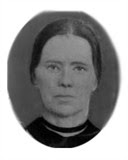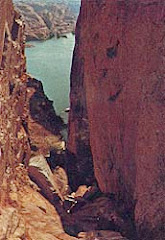| Ship Windermere painting [Click on images to enlarge] |
Voyage of the Ship Windermere
Condensed from W. W. Burton’s Account
Note: This is from a copy made on March 23, 1944, from the British Mission records of 1854 by Evelyn A. Sessions. It is of interest to the Robb family as George and Sarah Green Holyoak were on board this voyage from Liverpool, England to the United States.
| Ship Windermere 1852 drawing State Museum of Victoria |
On Wednesday, February 22, 1854, the ship Windermere sailed from Liverpool with 460 passengers. As the vessel started in motion, the songs of Zion, blending in soul-inspiring harmony, thrilled the souls of the passengers and their many friends standing on the shore gazing at the departed vessel, shouting farewell, goodbye with eyes streaming with tears. Doubtless they were recalling that only the night before seven vessels, with all on board, went down in the depths of the channel.
| H.M.S. Windermere Poop drawing |
As the land disappeared in the distance the sweet singing ceased and many began to feel sick. About 8 p.m. the first day at sea, an old gentleman named Squires died. All that night the wind howled fiercely; the sea was rough; the ship was driven from its course towards the Isle of Atan. About 11 p.m. off Holly Head, which is a most dangerous point and the scene of frequent shipwrecks, was passed. On the morning of the 23rd Father Squires, who died the night before, was thrown overboard. The sea was still rough and the wind was blowing. During this day the Windermere sailed by the remains of a wrecked vessel. Masts, sails and other fragments were floating around. Likely, a few hours previous many despairing souls had tenaciously clung to these same objects for relief that never came. All had been consigned to a watery grave for no signs of life remained and the rolling waves swept over the bodies while the wind howled its tribute for the dead.
Some were now beginning to recover from sea sickness, but many were still ill, and some confined to their berths. About this time flying fishes were seen which would rise from the water and fly a short distance and drop into the water again. Life on the Windermere was growing monotonous, for its accommodations were poor for so many passengers, and then it did not sail like the ocean steamers now do when propelled by steam. The Windermere was eight weeks, four nights, and five days sailing from Liverpool to New Orleans, which can now be made in six or seven days. We were on the Atlantic Ocean about seven weeks without seeing land.
| H.M.S. Windermere Between Decks drawing |
On the 12th day of March, from 7 to 8 in the morning, an exceedingly fierce storm arose. The wind roared like one of our mountain winds, the masts cracked and the sails were cut in pieces. The captain of the Windermere expressed fears that the ship could not stand so heavy a sea, and in speaking with Daniel Garn, the president of the Saints on board, said, "I am afraid the ship cannot stand this storm, Mr. Garn, if there be a God, as your people say there is, you had better talk to Him if He will hear you. I have done all that I can for the ship and I am afraid with all that can be done she will go down."
Elder Garn went to the Elders, who presided over the nine wards in the ship, and requested them to get all the saints on board and to fast, and call a prayer meeting to be held in each ward at 10 a.m. and pray that they might be delivered from the danger. The waves were lashed with white foam, the storm continued in all its fury, but precisely at 10 a.m. the prayer meeting commenced and such a prayer meeting few have ever seen.
| Deck of Windermere |
The ship rolled from side to side. On one side the Saints were hanging by their hands, and the other they were standing on their heads. Then the ship would roll on the other side which would reverse their positions. About this time the large boxes which were tied with ropes under the berths broke loose with pots, pans and kettles and rolled with terrible force on each side of the vessel.
Although the prayers were fervent and earnest, as the pleadings of poor souls brought face to face with danger and death, they ceased their prayers to watch and dodge the untied boxes, and great confusion prevailed for some time. The wind roared like a hurricane. Sail after sail was torn to shreds and lost. The waves were very large and as far as the eye could see, seemed to be one angry mass of rolling white foam. The hatches were fastened down. This awful storm lasted about 18 hours, then abated a little, but it was stormy from the 8th of March until the 18th. Observation taken by the quadrant showed that the ship was in the same latitude as it was on the 8th.
On the 14th of March, which was two days after this terrible storm, smallpox broke out. Of the three sisters, one was taken down with it. She had a light attack and recovered, but her two sisters then came down with it and both died, and after that 37 others, 40 in all, came down with it. Three days after the breaking out of smallpox, the ship took fire under the cooking galley. At this time we had not seen land for three weeks or more; when the cry of "Fire! The ship is on fire," rang throughout the vessel, and wild excitement and consternation prevailed everywhere. The sailors plied water freely, all the water buckets on board were brought into use and soon the fire was under control.
| Winderemere Cuddy painting 1847 |
When the last of the three sisters, who took smallpox, died it was evening. W. W. Burton thought he would get a good place from which to see the body thrown overboard; so he got outside the vessel and seated himself on the ledge extending out from the deck, placing each arm around a rope that led to the rigging. His feet were hanging over the ocean and the ship was sailing about at 10 knots. By this time darkness was fast setting in, but here he sat waiting to get a good view when the corpse would be thrown into the watery grave, where some said sharks were constantly following for prey. Brother Burton went to sleep and the funeral passed without his knowledge. The sound of feet walking on the deck aroused him from his slumber. A chill ran through him; his hair almost stood on end when he sensed his condition. Here he had been asleep, his feet were hanging off the side of the vessel which was rocking to and fro. He wondered how he had escaped falling overboard. It was now totally dark. He climbed into the ship and resolved never to expose himself so again. About this time the stench of the smallpox was fearful in every part of the vessel.
| Scene on board H.M.S. Windermere 1846 painting |
Emma Brooks was the name of the young lady just thrown overboard. Her sister Fanny had died the same day about half past one o’clock p.m., and was also thrown overboard about two o’clock. The funeral services were very impressive; a funeral at sea is the most melancholy and solemn scene perhaps ever witnessed, especially when the sea is calm. A stillness like that of death prevailed with us while an old sailor, at intervals, would imitate the doleful tolling of the bell of some old church, such as heard in some parts of England. Funerals were becoming frequent.
About the time the Windermere had been about six weeks out of Liverpool and the passengers had never seen land from the time they had entered the Atlantic. The days were generally mild and the weather very pleasant. The sun set and the bright, pale moon seemed to be straight above our heads. On the 8th day of April we came in sight of the Island of Cuba. On this day, about 10 a.m., a young man named Dee, died of smallpox. At the time of his death the wind had ceased blowing, not a ripple upon the waters. The sea appeared bright and clear, and seemed as smooth as a sea of glass. The young man that had just died was sewed up in a white blanket and at the feet was placed a heavy weight of coal. A plank was then placed with one end resting in the porthole in the side of the ship and other near the main hatchway. The body was then placed on this plank. The doleful tolling of the bell began. Elder McGhee made a brief address suitable for the occasion and offered a short prayer, after which the body and bedding of the young man were thrown overboard. The ship was standing perfectly still and the body could be seen sinking in the water until it appeared no longer than a person’s hand. Some thought it was seen sinking for a full 15 minutes, others still longer; some said a half hour.
The passengers of the Windermere had passed through a terrible storm, the panic created by the ship taking fire, their number decreased by smallpox, still another fearful calamity threatened them. The fresh water supply was getting short, and the store of provisions was falling. The passengers were limited to one hard, small sea biscuit for a day’s rations.
| Windermere in the Trades 1846 |
The Captain sent some sailors in a small boat to intercept a ship that was passing in the hopes of getting more provisions, but they failed. The Windermere now passed the western points of the Island of Cuba. The passengers had a good view of the lighthouse located on the most western point. The Gulf of Mexico was before them. The Gulf Stream flowed in like a vast river. Just think of this stream 500 miles across, very deep and constantly flowing.
On the morning of the 20th of April the ship entered the mouth of the Mississippi River. The passengers were more glad to look upon the plantations of orange groves that bordered the banks of the river than the great strong surging waves of the Atlantic which they had left behind them. Sometimes the Negroes would call from the shore and bid the emigrants welcome.
The Windermere set sail 22nd of February 1854 from Liverpool, England, arrived at New Orleans 23 April, 1954. During the voyage winds were encountered, arising at times to heavy gales. But at the end of five weeks favorable winds set in and the ship made 1,000 miles in four days.
Six marriages were solemnized on board, six births and 10 deaths occurred.
Millennial Star, Vol. 16, pp. 140, 193, 345, 477
Church Emigration. Vol. 2 p. 185—1868
Of the Craner family who were on this ship, the father, George Benjamin Craner, died of Cholera while crossing the plains to Salt Lake City. He was buried in the same grave along with a young girl and a child. Because the people were dying so fast, they didn’t have time to dig enough graves.
____________________________
Source:
http://www.craner.org/index.php?option=com_content&task=view&id=18&Itemid=30
























